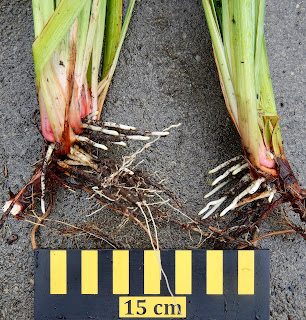Friday, September 30, 2022
Waiting for Rain on the West Coast
Monday, September 26, 2022
A Unique Iris Planting in New Orleans, Louisiana
by Patrick O'Connor
Members of the Greater New Orleans Iris Society have been hard at work curating a unique iris planting in New Orleans City Park. The planting is three-quarters of an acre and provides the space and opportunity for volunteers to maintain an extensive collection of species and hybrid Louisiana irises.
We recently created an eight-minute video to support recruitment and membership efforts. It highlights the range of irises and club activities.
 |
| Video Link |
Tuesday, September 20, 2022
Growing Irises Out East: A Visit to Draycott Gardens
 |
| Carol Warner (center) conducting a training session on Siberian irises for regional meeting attendees |
|
|
Although Carol's husband David isn't as passionate as she is about gardening, he enthusiastically supports her efforts. David happily keeps grass down with his zero-turn mower, moves soil from one place to another with a small tractor, and uses his considerable computer skills to aid Carol in the various activities that come with owning a commercial iris garden.
 |
| More blooms to enjoy among irises growing for resale |
 |
| Heather was is quick to spot historic iris 'Loreley' (one of her personal favorites) |
 |
| Alleah is quite fond of historic iris 'Skating Party' |
 |
| A spectacular clump of 'Dividing Line' growing among peonies in bloom |
 |
| 'Little John' is a creation from Region 4 hybridizer Don Spoon |
We were so taken with our visit to Carol’s garden during the regional meeting that we accepted her invitation to return and capture more pictures of it before heading back to North Carolina. During our second arrival, Carol greeted us from her golf cart as she speeded along sprucing up the garden. Later that day she would be playing handbells at her church’s Sunday service, and return to host an “Open Garden” event for friends, church members, horticultural society guests, and folks enticed by garden announcements courtesy of the local radio station.
A million thanks to Carol and David, for your hospitality, and for sharing the beauty of your farm and gardens with our family and so many others.
Monday, September 12, 2022
Louisiana Iris Conservation Initiative is Gearing Up for This Year's Projects
by Gary Salathe
The Louisiana iris Conservation Initiative (LICI), of which I am a member of the board of directors and a volunteer, managed to get 6,000 wild Iris giganticaerulea (a species of Louisiana iris) planted in refuges and nature preserves last year. The hard work paid off, as shown in my last World of Irises Blog posting. We're targeting getting at least 6,000 irises "rescued" and planted again for 2022.
The first step in accomplishing this goal is to locate irises that are threatened with destruction and dig them up. That process has already begun with our completing three "rescues" so far this year that has brought in about 4,000 I. giganticaerulea irises to our iris holding area.
 |
Some of the irises from early spring are almost ready to move out to our projects, as shown in this photo taken on August 5th. |
 |
The same Iowa State University volunteers at the LICI iris holding area planting the irises they rescued the day before. |
Our friends from the local non-profit Common Ground Relief were hosting the Iowa State University volunteers for a week of service activities in Southeast Louisiana doing marsh restoration projects.
In June volunteers from the Students Shoulder to Shoulder organization worked with us to complete our second and third iris rescue of the season. The volunteers were high school students from around the country. They were in south Louisiana for a week of volunteering in coastal restoration projects through events held by their local host Common Ground Relief.
 |
Both of the June 2022 iris rescue events were held while the area was experiencing a heat wave with temperatures in the mid-90's. |
 |
Josh Benitez (left), co-director of Common Ground Relief, is seen digging irises with two volunteers from the Students Shoulder to Shoulder organization during one of the June iris rescue events. |
Because of the very wet weather our area has been experiencing, we likely will not be able to get out to do any more iris rescues until the middle of September. One more event should get all of the containers full at the LICI iris holding area.
We are going to be doing some maintenance at the iris holding area over the next two weeks and will also be coming up with a plan for where the irises will be planted this fall and winter. New sites have contacted us about having our irises planted there and we'd like to plant more irises at many of our ongoing projects. We're hopeful the weather will cooperate during November to allow us to get some iris rescue projects done where we can dig one day and plant the irises in projects the next day.
We will also be working over the next few weeks on getting donations to fill out our budget for the year. We welcome any size donation to help with the overhead expenses that we incur with maintaining our iris holding area and putting on volunteer events.
We are an all-volunteer-run Louisiana-registered non-profit that aims to have a big impact at a small cost. Clicking the button on our homepage will allow you to make a donation to us even if you do not have a PayPal account. A credit card will work. Any help that you can give will be greatly appreciated. Thank you so much!
The Louisiana Iris Conservation Initiative website can be found here: https://www.licisaveirises.com/
Recent articles about our work can be found here: https://www.licisaveirises.com/news
Our Facebook page can be found here: https://www.facebook.com/licisaveirises
Our email address is: licisaveirises@gmail.com








.jpg)




.JPG)
